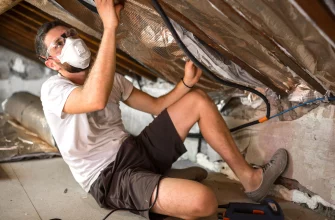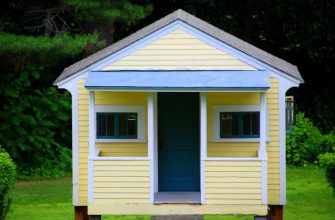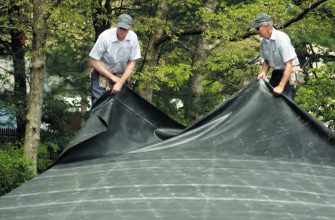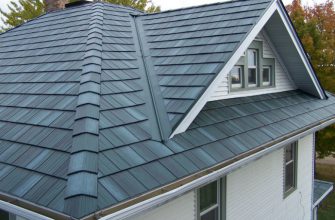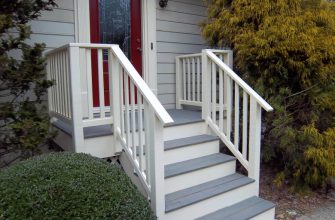Installing a wheelchair ramp for a mobile home is an important modification that can greatly improve accessibility and quality of life. A properly constructed ramp allows wheelchair users and those with mobility limitations to safely enter and exit their home independently.
This comprehensive guide will cover everything you need to know about building wheelchair ramps for mobile homes, from design considerations to step-by-step installation instructions. We’ll discuss critical factors like ramp length, slope, landings, materials, and compliance with legal requirements for accessibility.
By the end, you’ll have the knowledge to construct a DIY wheelchair ramp that provides safe, reliable access to your mobile home.
- Definition of Wheelchair Ramps for Mobile Homes
- Importance of Wheelchair Ramps for Accessibility and Inclusivity
- Factors to Consider When Building a Wheelchair Ramp for a Mobile Home
- Selecting the Location and Determining the Length and Shape of the Ramp
- Guidelines for Measuring and Laying Out the Landing, Adjusting Batter Boards, and Installing Footings
- Compliance with Local Rules and Potential Need for Building Permits
- Building a DIY Wheelchair Ramp for a Mobile Home
- Step-by-Step Guide for Measuring, Assembling the Frame, and Constructing the Ramp
- Considerations for Using Treated Lumber, Screws vs. Nails, and Creating Landings for Longer Ramps
- Accessible Living and Legal Considerations
- The Impact of Wheelchair Ramps on Accessible Living in Mobile Homes
- Insights on Medicare Coverage for Home Modifications and Maximum Slope Recommendations
- Conclusion
Definition of Wheelchair Ramps for Mobile Homes
A wheelchair ramp is an inclined plane installed to provide access for wheelchair users and others with mobility disabilities into and out of a building. Ramps allow access without climbing stairs.
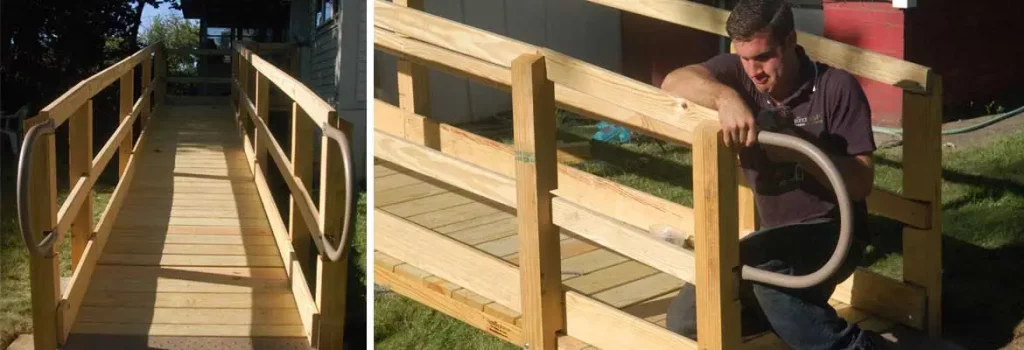
For mobile homes specifically, wheelchair ramps are exterior structures built to bridge the height difference between the ground and the main entry door threshold. Most mobile homes sit on some type of foundation above ground level.
Wheelchair ramps provide a sloped platform for safely maneuvering mobility devices such as manual chairs, power chairs, scooters, and walkers up to and into the home.
Importance of Wheelchair Ramps for Accessibility and Inclusivity
Installing a wheelchair ramp levels the playing field for people with disabilities. It supports independent living by enabling users to come and go from their home safely on their own.
Ramps uphold principles of accessibility, inclusion, and equal opportunity in housing. They eliminate barriers and let residents fully participate in community life.
Building codes and legislation like the Americans with Disabilities Act (ADA) establish legal standards for accessibility. While not all homes are required to comply, ramps should follow best practices for maximum usability.
Factors to Consider When Building a Wheelchair Ramp for a Mobile Home
Selecting the Location and Determining the Length and Shape of the Ramp
The ideal location for a wheelchair ramp maximizes accessibility while working within spatial constraints. Measure thoroughly and stake out an optimal path balancing convenience and your build budget.
The ADA recommends ramps be at least 36 inches wide – 42 inches if there is a handrail – to allow room for maneuvering mobility devices. Ramps can be straight or feature switchbacks to fit the space.
Guidelines for Measuring and Laying Out the Landing, Adjusting Batter Boards, and Installing Footings
Use batter boards, mason’s line, a bubble level, and the 3-4-5 measuring method to mark a level ramp path in the correct location. Footings stabilized in concrete anchor the ramp framework in place.
The landing area at the door should be a minimum of 60 x 60 inches for maneuvering room. Always check local building codes for specific requirements.
Compliance with Local Rules and Potential Need for Building Permits
Most areas allow homeowners to build DIY ramps on private property within certain guidelines. However, be sure to check municipal statutes for exemptions, restrictions, or permitting regulations.
Some neighborhoods mandate ramps match the home aesthetically. Understanding the legal landscape is key for a smooth project.
Building a DIY Wheelchair Ramp for a Mobile Home
Step-by-Step Guide for Measuring, Assembling the Frame, and Constructing the Ramp
With proper planning and some carpentry skills, you can construct a wheelchair ramp yourself. Here is an overview of the process:
- Measure space and calculate ramp length/configuration.
- Install footings and anchor posts for framework.
- Attach stringers, joists, and decking boards to assemble ramp.
- Add protective railings if required.
There are many small nuances at each phase. Having an experienced helper is extremely valuable for beginners.
Considerations for Using Treated Lumber, Screws vs. Nails, and Creating Landings for Longer Ramps
Treated lumber stands up to outdoor weathering and provides stable support. Use exterior wood screws – not nails – for durability.
For ramps exceeding 30 feet, incorporate 4×4-foot rest landings every 30 feet to prevent fatigue. Always build landings large enough to safely turn a wheelchair around.
Accessible Living and Legal Considerations
The Impact of Wheelchair Ramps on Accessible Living in Mobile Homes
Wheelchair ramps are essential for accessible independent living. A well-built ramp enables people with disabilities to easily and safely:
- Enter/exit home independently.
- Access vehicle and driveways.
- Come and go from residence freely.
This restores freedom and dignity without relying on others for assistance with daily activities.
Insights on Medicare Coverage for Home Modifications and Maximum Slope Recommendations
Medicare does not cover home modification costs but many Medicaid waiver programs do. Veterans can also receive grants for handicap accessibility projects.
ADA guidelines call for ramps not exceeding a 1:12 slope ratio. This equates to a maximum of 1 inch of rise per 12 inches of ramp length.
Conclusion
Installing wheelchair ramps requires planning and know-how, but is very doable as a DIY project. This guide covers the entire process start-to-finish to empower you to build an access ramp for your mobile home.
By following the techniques and recommendations above you can create a ramp that meets your needs for accessibility, functionality, safety and aesthetics.


